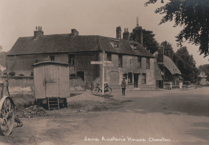ONE of the oldest buildings in the Woking area must be Ramwick Cottage, located close to the town centre on Park Road, writes David Rose.
Believed to date back to the seventeenth century, Peeps into the Past researcher Mark Coxhead and I have been delving into its history, with help from the current owners.
It was once a hostelry named the Castle Ramwick Inn and stood on what was then an area of rather wild and scantily populated heathland. It’s believed it ceased to be an inn – or more likely a beer house without a full licence – sometime in the second half of the nineteenth century.
Back in 1951 its owners were Mr and Mrs Clifford, who had bought the cottage two years earlier. They were visited by GH Campbell, who wrote an article about the cottage. This was published in the News & Mail of 30 March 1951.
Campbell appeared to have been much taken with a somewhat fanciful tale that the notorious highwayman Dick Turpin spent a night at the Castle Ramwick Inn in the early 1730s.
The article states: “Unfortunately, the thatched roof under which Dick Turpin slept had to be removed. It was badly rotted and a haven for rats. Mr Clifford has replaced it with tiles, over 400 years old, from Ripley.
“Imagine the time is still the early 1730s and you are visiting the inn. It stands at the side of a rough road at the edge of a wood. Outside the tap room door there is a hitching post for casual horsemen, whilst at the rear of the building timber stables house the horses of resident guests. It is here that Turpin kept Black Bess.

“The tap room itself is small and roughly furnished with wooden chairs and tables. It has a brick floor and at the far end a stone fireplace.
“On the right as you enter there is a door, which leads to the living quarters of the innkeeper and his family; the winding stairs [lead] to the guests’ rooms and the attic.
“It is said that Turpin, when taken by surprise by the law, escaped through this door, up the stairs to the attic and through a chute to the stables and then galloped away across the fields to Chobham, where he had another hideout.
“Unfortunately, I have no written confirmation of this fact, or of the belief that the villagers of Chobham when they knew Turpin was in close proximity, gathered their valuables and hid them in an underground tunnel beneath the main village road.”
All good stuff of legend, of course, but does some evidence exist to support this? I wonder when and where the tale originated?
However, Campbell does describe some lovely details that he observed.
“One the left, as one enters the front door, is the lounge. It is a long room magnificently timbered and Mr Clifford estimates that there are over 30 beams in this room alone.
“At the far end there is a recess fireplace, which, although it has been lined with small bricks, is exactly as it was in Turpin’s day. In the recess is a genuine Adam grate of the same period.
“On the roof, swinging with the prevailing wind, is a weathervane in the form of a highwayman challenging a coach. This was recently bought by Mr and Mrs Clifford from an antique shop – it being too appropriate to resist!”
If you have some memories or old pictures relating to the Woking area, call David Rose on 01483 838960, or drop a line to the News & Mail.
David Rose is a local historian and writer who specialises in what he calls “the history within living memory” of people, places and events in the west Surrey area covering towns such as Woking and Guildford. He collects old photos and memorabilia relating to the area and the subject, and regularly gives illustrated local history talks to groups and societies. For enquiries and bookings please phone or email him at: [email protected]




